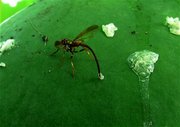By Gardener Jack
Papaya is a very popular fruit that is grown in most backyards in The Bahamas. There is a tendency to call the fruit 'papaw' or 'paw-paw' but this could be confusing as there is another fruit called paw-paw that is banana-like and grows in the southeastern United States.
A couple of years ago I gave a talk to farmers in Abaco and during the question and answer session the concern was almost completely about the destruction of papaya by the papaya fruit fly. What could be done about it? Were there any sprays that could protect the plants?
Sadly, the answer is no. For backyard gardeners and small-scale farmers the only practical way to protect papayas is the old fashioned way: bag 'em. The process is tedious and destroys the ambiance of the papaya trees as tropical focal points. The farmer may not mind so much but paper bags are as irritating on papayas as they are blown onto the lawn.
The papaya fruit fly (Toxotrypana curuicauda) resembles a small wasp marked with yellowish-orange and black bands. The outstanding feature, literally, is an ovipositor several times the length of the fly. This is used to inject eggs into a papaya fruit and is usually done when the fruit is mature enough to have developing seeds.
As the female lays her eggs she also introduces a chemical that causes the fruit to decay, making it more digestible to the larvae that will be produced from the eggs.
A female papaya fruit fly produces about 100 eggs and lays around 10 at a time in each papaya fruit it visits. The eggs are yellow and elongated and hatch within 12 days, producing the aforementioned larvae (maggots, worms in Bahamian). The larvae feed on the undeveloped seeds and the interior tissue of the fruit for 15-16 days and then eat their way out of the fruit. To do this the fruit must be ripe, or at least the section they pass through.
The larvae drop to the ground and bury themselves just below the surface of the soil. Anywhere from 2 - 6 weeks later they pupate into new adult flies and the process starts all over with female papaya fruit flies being fertilised and looking for fruit, usually mine, to lay their eggs.
At this stage, paper bags are the only prevention. A one to two-pound bag can be placed over a fruit once it has dropped its flower and the top crimped to hold it in place. A half a sheet of newspaper can also be used, folding it around the fruit and securing it with paper clips, staples, or plastic ties.
Good practice for gardeners would be to interrupt the life cycle of the papaya fruit fly. Once an infected fruit has been identified it can be picked off, split, and put in a bucket of water to kill the larvae. If you give a papaya tree a shake only infected fruit will fall.
Perhaps in the future we will have less in the way of problems with the papaya fruit fly. Scientists are working to produce seedless papayas. Because the fruit fly larvae depend on seeds to feed on they will be starved and die. I'm still not sure I would want to eat the fruit, however. Another possible remedy is to breed papayas with a tougher skin or with fruit so thick that the ovipositor cannot reach the interior cavity.
I have noticed that the traditional Bahamian papaya tends to be both thicker skinned and bear heavier fruit and seems to be affected far less by the papaya fruit fly than smaller varieties.
For large-scale papaya production pheromone traps have been developed that attract the female papaya fruit fly. These would be impractical for the backyard gardener but useful to farmers with several acres of fruit trees to protect.
gardenerjack@coralwave.com





Comments
Use the comment form below to begin a discussion about this content.
Sign in to comment
Or login with:
OpenID